Nine Oscars red-carpet outfits once mocked – now iconic
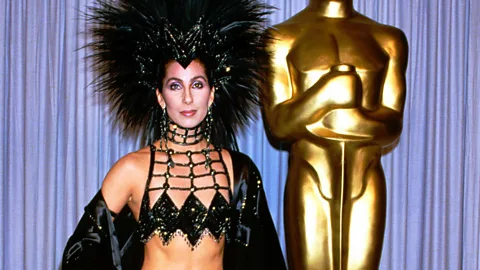 Alamy
AlamyFrom Babs to Bjork, here are the bold looks that were once derided at the Oscars but are now celebrated and deemed cool. Clare Thorp looks backs over the decades.
When Kristen Stewart turned up at last year's Oscars ceremony in custom Chanel hotpants, a cropped tuxedo jacket and a sheer white shirt unbuttoned to her waist, it was hailed by many as an iconic fashion moment – but not a shocking one. Here was one of Hollywood's most singular young actresses using the red carpet to express her individuality. "It was the one opportunity to be me," she said of her choice. Likewise with Timothée Chalamet's sequinned Louis Vuitton jacket – a piece from the womenswear collection. Young Hollywood was showing that when it comes to the red carpet, there are no rules – but that hasn't always been the case.
More like this:
The Academy Awards aren't just film's biggest night of the year, but fashion's too. As Dijanna Mulhearn, author of new book Red Carpet Oscars, tells BBC Culture: "A successful red-carpet moment can catapult an actor into superstar status, propel a fashion label into a desired household name, result in lucrative commercial contracts, and secure the next starring role."
Everyone wants to make an impact on the red carpet – but over the years certain outfits have caused much more of a stir than others, from Bjork's unforgettable swan dress to Gwyneth's maligned goth-punk moment to Billy Porter's dramatic tux dress. For some celebrities, grabbing people's attention was the whole point – while others had no idea their outfits would cause such outrage. Yet however controversial these outfits were at the time, there's no doubt that it's the boundary-pushing looks that we remember the most, even if, today, it's sometimes hard to see what all the fuss was about.
"[These outfits] shifted something, and challenged the strict female and male dress codes," says Caroline Stevenson, programme director of fashion studies and cultural and historical studies at London College of Fashion, UAL. "But we realise, as we go on, that's not so shocking. Something changes the bar and then we get used to it and then we move on." Here we remember nine shape-shifting Oscars fashion moments.
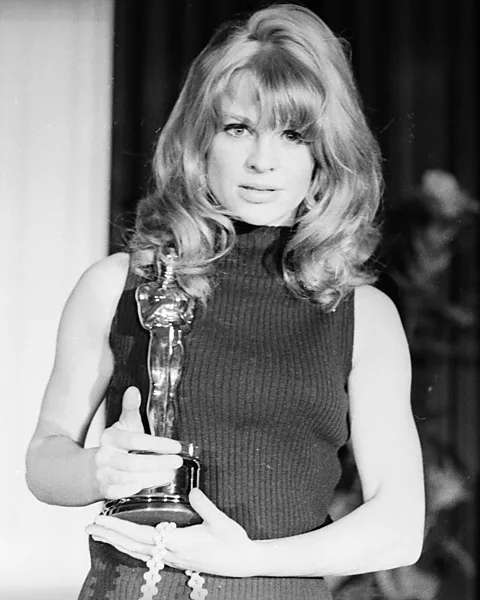 Getty Images
Getty Images1 Julie Christie, 1967
By the time she arrived at the 1967 Oscars ceremony, Julie Christie already had a reputation for rebellious red-carpet dressing. The previous year, when she'd won the best actress award for her role in Darling, she'd shown up in a homemade gold lamé jumpsuit, making her the first ever woman to accept an Oscar while wearing trousers. But it was the following year's polka-dot, off-the-rack mini dress that really caused a stir.
After the show began to be televised in the 1950s, The Academy appointed costume designer Edith Head to serve as a fashion consultant for the ceremony. "She was backstage with a whole kit of tools to smarten up actresses who might have been a little too exposed, like rosettes to cover cleavage, or a chiffon wrap to put over a skirt that was slit too high or too short," says Mulhearn. Mini skirts certainly weren't deemed proper clothing for an awards ceremony at the time – least of all a high-street version.
"But Julie Christie managed to breeze past Edith Head with her sunny smile, and Edith didn't look up until she heard the audience gasp," says Mulhearn. It was a pivotal moment in Oscars' fashion, when fashion protocol began to give way to freedom of expression. That year Time magazine said what Christie wore had "more real impact on fashion than all the clothes of the 10 Best-Dressed women combined".
"Julie Christie broke the rules," says Mulhearn. "The floodgates opened thanks to her."
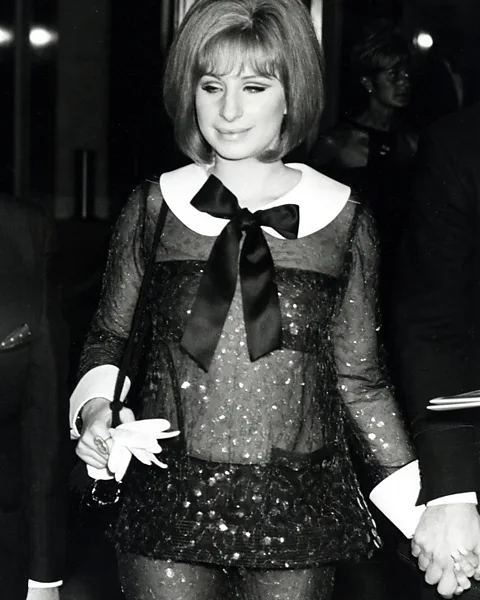 Getty Images
Getty Images2 Barbra Streisand, 1969
Up for her first best actress Oscar for Funny Girl, a 26-year-old Barbra Streisand was weighing up two outfit options; a classic and conservative Dior gown, or an Arnold Scaasi sequinned, bell-bottomed pantsuit. "I think somebody said to her, well, if you wear [the pantsuit], you'll really make a statement. And that's all she needed to hear. So she went with the party pyjamas, not realising that under the lights, they were completely see through," says Mulhearn. "As she mounts the stairs her butt was there for everyone to see, and the only person who doesn't know that is her."
That year the best actress winner was an historic tie between her and Katharine Hepburn, but only Streisand was present to collect her award – and her outfit meant that it was she who dominated the front pages the next day. "It was another example of young people busting out of the norms and breaking away from the shackles of what an older generation dictated to them, saying: we're free and independent and we make our own decisions," says Mulhearn.
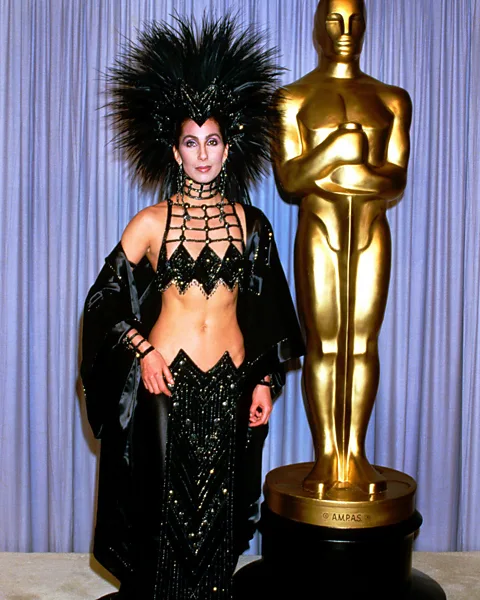 Alamy
Alamy3 Cher, 1986
Cher had a point to prove at the 1986 Oscars. Snubbed for an acting nomination for her role in Mask – despite winning best actress at the Cannes Film Festival – she was determined no-one was going to ignore her on the night. She instructed her friend and long-time collaborator, designer Bob Mackie, to go wild – and he certainly followed the brief. Consisting of a black-crystal-encrusted bralet, a perilously low-rise skirt and a cashmere shawl, the look was completed – and dominated – by a huge feather headdress. "I said I wanna have a mohawk, and I want to do something that's not actually Indian but I want it to be so over-the-top that it's next week," Cher told Vogue in 2020.
"She said to Mackie, let's go crazy. Make it outrageous," says Mulhearn. "Bob Mackie was telling me that while he was sketching with her he said to her, this is too much. And she said, no it's not enough. I want to blow them away. They'll not forget me again. They will not miss me again. And two years later, she won best actress for Moonstruck." And, of course, she wore another scene-stealing Bob Mackie creation for the occasion.
 Getty Images
Getty Images4 Gwyneth Paltrow, 2002
"Everybody really hated this [dress]... but I think it's kind of dope," Gwyneth Paltrow said in 2021, recalling her much maligned 2002 Oscars look. At the time, the Guardian's fashion editor called her Alexander McQueen outfit "more Camden Market than red carpet", while Suzy Menkes of the International Herald Tribune said Paltrow looked like she was "off to see her personal trainer".
Mulhearn says the criticism was unfair. "I actually thought it was a good choice, and from a fashion perspective gave her more depth," she says. "I think one of the reasons people reacted so badly was because when she had won her best actress award a few years earlier, she looked so pretty, almost like a princess. And then suddenly she comes in a completely different look, and it was jarring to see her go so opposite."
Caroline Stevenson agrees that Paltrow was targeted for daring to try something different. "I think it's a really beautiful look but I can totally see why it was kind of vilified," she says. Paltrow has since said she regrets not wearing a bra. "But I think it was more the severity of her hair, makeup and jewellery, which came across as kind of semi Gothic, that people were critiquing her on," says Stevenson. "I just don't think people were ready to see something almost borderline subculture on the Oscars red carpet. It just demonstrates how rigid the dress code is around the Oscars, and how anything that even slightly veers from that is, for some reason, very shocking to the press or to the public."
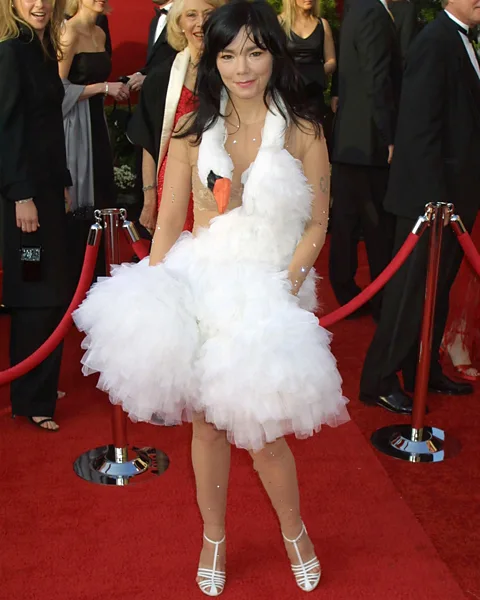 Getty Images
Getty Images5 Bjork, 2001
Ask anyone to name a memorable Oscar's red-carpet moment and chances are they'll mention Bjork's 2001 appearance, when she turned up in a dress that resembled a swan, its orange beak resting on her chest. Her accessories were a trail of eggs she laid behind her as she went. The red-carpet critics went to town. "The girl should be put into an asylum," sniped Joan Rivers. "Probably one of the dumbest things I've ever seen," said TV fashion pundit Steven Cojocaru. But the white tulle dress – by Macedonian designer Marjan Pejosk – is now seen as an iconic part of fashion history, featuring in exhibitions at MoMA and the Met, and even inspiring a Valentino couture gown.
Bjork – who was nominated for best original song for I've Seen It All from Dancer in the Dark – said she thought it would be her first and last time at the Oscars, and she wanted to make a statement about fertility. "She was vilified but she stuck to her guns," says Mulhearn. "She wore that outfit numerous times afterwards. She didn't care what people thought, she had a point of view. And because she had such a point of view, here we are talking about her over 20 years later."
 Getty Images
Getty Images6 Nicole Kidman, 1997
At first glance, there doesn't seem to be too much controversial about Nicole Kidman's 1997 Christian Dior gown, a satin chartreuse-coloured couture creation by John Galliano, who had recently been appointed creative director for the design house. But it marked a landmark moment for the Oscars red carpet. "The dress was magnificent, but it was a polarising colour, and unfortunately for Nicole Kidman, this was the time where, thanks to Joan Rivers, the red-carpet critic was really rising," says Mulhearn. Rivers, who had hosted E!'s pre-awards show since the mid-90s, called it "the ugliest dress I've ever seen".
She didn't stop there. "She literally put her finger down at her throat on TV, which was so outrageous in itself, but what it also did was terrify all the actresses on the red carpet, making them start to question their own taste and doubt their choices."
No-one wanted to be Rivers' next target, so stars increasingly started to rely on personal stylists to dress them. "That's really when the commercialisation of the red carpet came to the fore," says Mulhearn. "Then, except for a few exceptions, it turned into the boring parade of pretty dresses that we saw from 2002 to 2010."
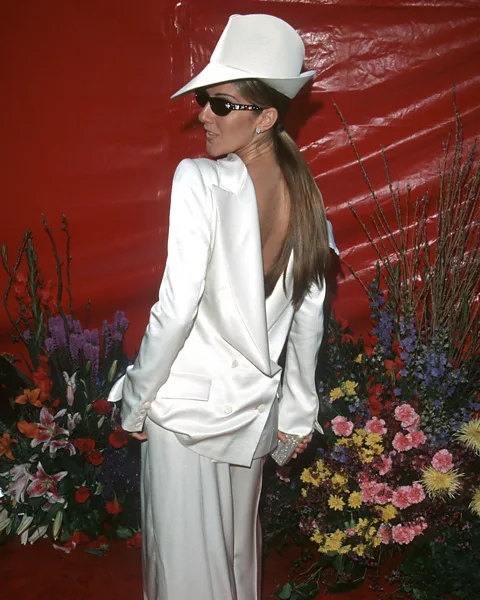 Getty Images
Getty Images7 Celine Dion, 1999
For Celine Dion's 1999 Oscars look it wasn't the outfit itself – a white satin John Galliano for Christian Dior tuxedo suit – that was unusual. It was how she wore it; with the jacket back to front. "I thought it looked fabulous," she Mulhearn. "How many white suits have we seen on the red carpet, from Diana Ross and Diane Keaton in the '70s through to the Angelina Jolie? There's been a million of them. I guess she just wanted to wear it differently."
But in a year when most other attendees were playing it safe, the red-carpet critics pounced on her. "People thought it was funny to criticise whatever they could cling to," says Mulhearn. "I don't think that one was very deserving of it. I thought it was a sensational suit."
It seems the fashion world was slow to catch on because, in recent years, the singer has emerged as something of a fashion icon precisely for her avant-garde choices and penchant for drama (she has shared a stylist with a more recent red-carpet risk-taker, Zendaya). "We know Celine Dion makes quirky fashion choices and we love her for it," says Mulhearn. "Again, she's someone who came from the music industry. Those people are the ones that take risks more than others."
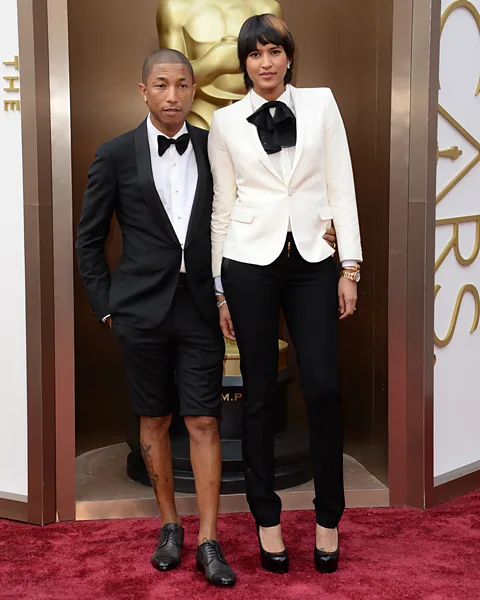 Getty Images
Getty Images8 Pharrell Williams, 2014
Like most of the men at the 2014 Academy Awards, Pharrell Williams, nominated for the song Happy from Despicable Me 2, showed up in a black tux – only his involved a pair of shorts instead of trousers. Dubbed a "bermuda tux", his Lanvin outfit was even more notable because he didn't wear any socks.
Once again, Joan Rivers had something to say, commenting: "He looks like he was representing the Lollipop Guild in the tribute to The Wizard of Oz." The New York Times called it a "dubious fashion trend", questioning whether shorts had a place at a formal event such as the Oscars.
Williams wasn't deterred – he wore a blazer and shorts again at the 2019 Academy Awards, this time a camouflage Chanel combo. By that point, people barely batted an eyelid, as other male stars like Timothée Chalamet and Jared Leto were pushing the envelope even further on the red carpet. "I really feel like this is the age of the individual, and we're leaning towards accepting self-expression, no matter what that is," says Mulhearn. "And I love that men are embracing that as much as women."
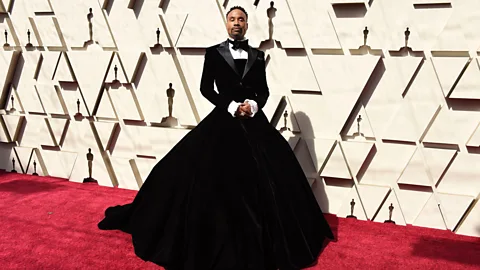 Alamy
Alamy9 Billy Porter, 2019
The last few years have seen a new red-carpet trailblazer emerge in Billy Porter. In 2019, the actor and singer wore a Christian Siriano tuxedo dress that combined a classic black velvet jacket, bow tie and white shirt with a full skirted strapless gown.
Porter said his goal was to be a "walking piece of political art", and to challenge expectations of masculinity. If women can wear trousers, why was it such a big deal if he wore a gown? "I am not a drag queen, I am a man in a dress," he said. "People are going to be really uncomfortable with my black ass in a ball gown – but it's not anybody's business but mine."
"It was just absolutely brilliant," says Caroline Stevenson. "I think it really stands out as a way to make a personal statement, within that rigid dress code, that is really reflective of what's going on in society, but also really reflective of his personality as well. And he did it with such confidence and such grace. It showed men's dress codes can be played with as much as female ones."
If you would like to comment on this story or anything else you have seen on BBC Culture, head over to our Facebook page or message us on Twitter.
And if you liked this story, sign up for the weekly bbc.com features newsletter, called The Essential List. A handpicked selection of stories from BBC Future, Culture, Worklife and Travel, delivered to your inbox every Friday.
